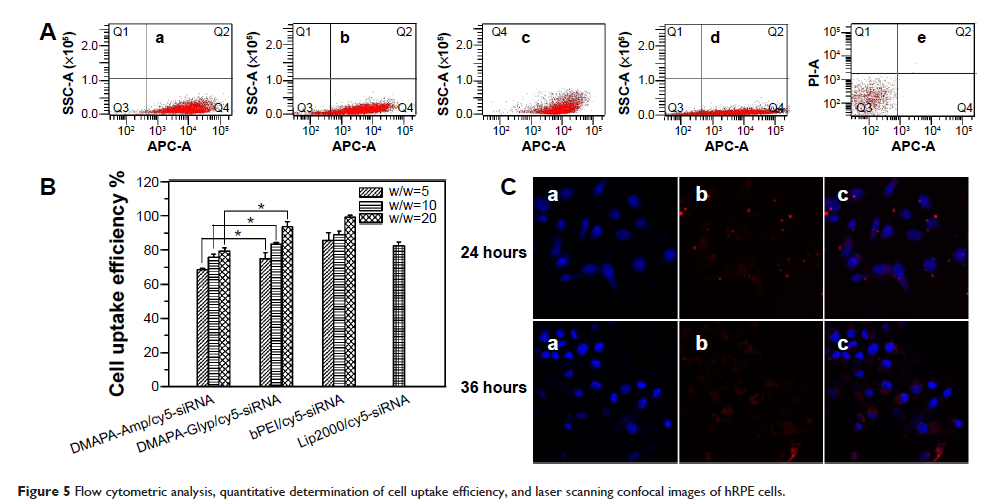9 5 9 4 4
论文已发表
注册即可获取德孚的最新动态
IF 收录期刊
- 3.3 Breast Cancer (Dove Med Press)
- 3.4 Clin Epidemiol
- 2.5 Cancer Manag Res
- 2.9 Infect Drug Resist
- 3.5 Clin Interv Aging
- 4.7 Drug Des Dev Ther
- 2.7 Int J Chronic Obstr
- 6.6 Int J Nanomed
- 2.5 Int J Women's Health
- 2.5 Neuropsych Dis Treat
- 2.7 OncoTargets Ther
- 2.0 Patient Prefer Adher
- 2.3 Ther Clin Risk Manag
- 2.5 J Pain Res
- 2.8 Diabet Metab Synd Ob
- 2.8 Psychol Res Behav Ma
- 3.0 Nat Sci Sleep
- 1.8 Pharmgenomics Pers Med
- 2.7 Risk Manag Healthc Policy
- 4.2 J Inflamm Res
- 2.1 Int J Gen Med
- 4.2 J Hepatocell Carcinoma
- 3.7 J Asthma Allergy
- 1.9 Clin Cosmet Investig Dermatol
- 2.7 J Multidiscip Healthc

已发表论文
超支化的阳离子多糖衍生物为基础的纳米颗粒将 NF-κB 的 siRNA 向人视网膜色素上皮细胞的高效输送
Authors Liu Z, Gong H, Zeng R, Liang X, Zhang LM, Yang L, Lan Y
Published Date April 2015 Volume 2015:10 Pages 2735—2749
DOI http://dx.doi.org/10.2147/IJN.S75188
Received 30 September 2014, Accepted 9 November 2014, Published 7 April 2015
Abstract: A hyperbranched cationic polysaccharide derivative-mediated small
interfering (si)RNA interference strategy was proposed to inhibit nuclear
transcription factor-kappa B (NF-κB) activation in human retinal pigment
epithelial (hRPE) cells for the gene therapy of diabetic retinopathy. Two
hyperbranched cationic polysaccharide derivatives containing the same amount of
cationic residues, but with different branching structures and molecular
weights, including 3-(dimethylamino)-1-propylamine-conjugated glycogen (DMAPA-Glyp)
and amylopectin (DMAPA-Amp) derivatives, were developed for the efficient
delivery of NF-κB siRNA into hRPE cells. The DMAPA-Glyp derivative showed lower
toxicity against hRPE cells. Furthermore, the DMAPA-Glyp derivative more
readily condensed siRNA and then formed the nanoparticles attributed to its
higher branching architecture when compared to the DMAPA-Amp derivative. Both
DMAPA-Glyp/siRNA and DMAPA-Amp/siRNA nanoparticles were able to protect siRNA
from degradation by nuclease in 25% fetal bovine serum. The particle sizes of
the DMAPA-Glyp/siRNA nanoparticles (70–120 nm) were smaller than those of the
DMAPA-Amp/siRNA nanoparticles (130–180 nm) due to the higher branching
architecture and lower molecular weight of the DMAPA-Glyp derivative. In
addition, the zeta potentials of the DMAPA-Glyp/siRNA nanoparticles were higher
than those of the DMAPA-Glyp/siRNA nanoparticles. As a result, siRNA was much
more efficiently transferred into hRPE cells using the DMAPA-Glyp/siRNA
nanoparticles rather than the DMAPA-Amp/siRNA nanoparticles. This led to
significantly high levels of suppression on the expression levels of NF-κB p65
messenger RNA and protein in the cells transfected with DMAPA-Glyp/siRNA
nanoparticles. This work provides a potential approach to promote hyperbranched
polysaccharide derivatives as nonviral siRNA vectors for the inhibition of
NF-κB activation in hRPE cells.
Keywords: glycogen, amylopectin, siRNA, nuclear transcription factor-kappa B, human retinal pigment epithelial cells
Keywords: glycogen, amylopectin, siRNA, nuclear transcription factor-kappa B, human retinal pigment epithelial cells
